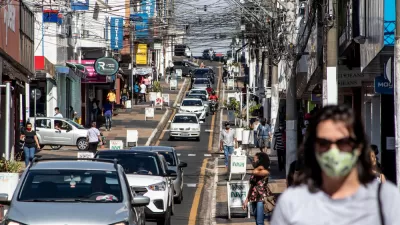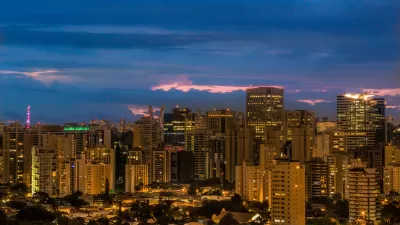Ecologists and planners have been warning that water may be the oil of the 21st century. With oil prices plunging, water is getting more dear in some places. Sao Paulo, Brazil's great megacity and economic heart, is already facing a dire shortage.

Drought isn't the only thing that causes a water shortage. In Sao Paulo, a devastating combination of deforestation, pollution, political corruption, climate change, shoddy infrastructure, and epic rates of urban growth—not to mention a drought—have the city on edge. The city's reservoirs are low, and the city's rivers are too polluted to drink from. City officials are considering rationing—possibly limiting water delivery to two days per week—and in some parts of the city of roughly 20 million, taps are already running dry.
This in a country with one-eighth of the world's freshwater.
"We’re witnessing an unprecedented water crisis in one of the world’s great industrial cities," said Marússia Whately, a water specialist at Instituto Socioambiental, a Brazilian environmental group. "Because of environmental degradation and political cowardice, millions of people in São Paulo are now wondering when the water will run out."
The water utility, Sabesp is building new reservoirs and has plans to draw from nearby rivers. It cannot build fast enough, though, to dampen the ire of many Paulistas. Meanwhile, a prominent Brazilian writer told the New York Times, "The majority doesn’t get indignant with anything,” he said, “as if we’re comfortably strolling toward our own demise."
FULL STORY: Taps Start to Run Dry in Brazil’s Largest City

Alabama: Trump Terminates Settlements for Black Communities Harmed By Raw Sewage
Trump deemed the landmark civil rights agreement “illegal DEI and environmental justice policy.”

Study: Maui’s Plan to Convert Vacation Rentals to Long-Term Housing Could Cause Nearly $1 Billion Economic Loss
The plan would reduce visitor accommodation by 25% resulting in 1,900 jobs lost.

Why Should We Subsidize Public Transportation?
Many public transit agencies face financial stress due to rising costs, declining fare revenue, and declining subsidies. Transit advocates must provide a strong business case for increasing public transit funding.

Paris Bike Boom Leads to Steep Drop in Air Pollution
The French city’s air quality has improved dramatically in the past 20 years, coinciding with a growth in cycling.

Why Housing Costs More to Build in California Than in Texas
Hard costs like labor and materials combined with ‘soft’ costs such as permitting make building in the San Francisco Bay Area almost three times as costly as in Texas cities.

San Diego County Sees a Rise in Urban Coyotes
San Diego County experiences a rise in urban coyotes, as sightings become prevalent throughout its urban neighbourhoods and surrounding areas.
Urban Design for Planners 1: Software Tools
This six-course series explores essential urban design concepts using open source software and equips planners with the tools they need to participate fully in the urban design process.
Planning for Universal Design
Learn the tools for implementing Universal Design in planning regulations.
Smith Gee Studio
Alamo Area Metropolitan Planning Organization
City of Santa Clarita
Institute for Housing and Urban Development Studies (IHS)
City of Grandview
Harvard GSD Executive Education
Toledo-Lucas County Plan Commissions
Salt Lake City
NYU Wagner Graduate School of Public Service




























